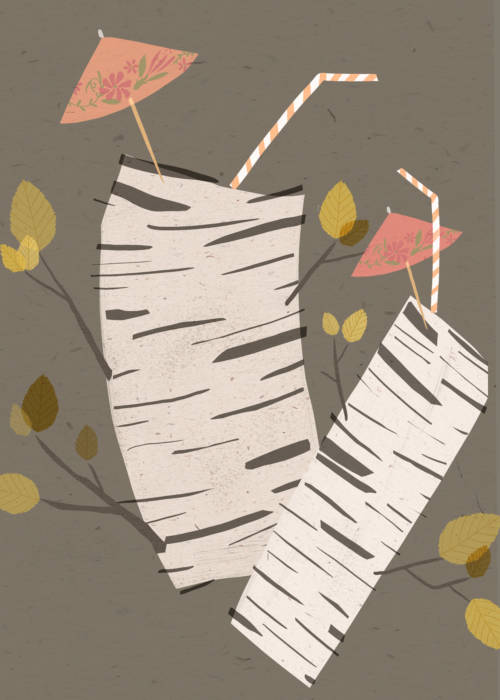
Is Birch Water The New Coconut Water?
In a land where coconut water and fruit-infusions reign supreme, a new kind of health fixation is cohering around birch water— a long-established Finnish tradition that involves tapping a birch tree and drinking the flavorful, water-like sap. Birch water is full of antioxidants and manganese (a potent stress-reliever) as well as electrolytes that support youthful skin, healthy bones, and overall vitality. It also goes without saying that it’s lower in natural sugars than coconut water (one 8-oz serving of birch water typically has about 10 calories, depending on brand and overall potency).
As fluid is transported throughout xylem cells in a Birch tree, water taken up by the roots distributes vital nutrients that Scandinavian populations have tapped from the trees every spring for centuries. Nutrients build up in the winter and make for a welcome, refreshing drink in the spring; Birch water has a slightly sweet, herbal flavor that is both subtle and pleasant.
As fluid is transported throughout xylem cells in a Birch tree, water taken up by the roots distributes vital nutrients.
Across the globe, there are a number of companies honing in on the trend– Sibberi, Tapped, and Byarozavik among them– but one company offering an excellent, modern twist on the tradition is Säpp, who package their birch water in glass bottles and offer Nettle and Rosehip varieties.
Säpp, whose founders John and Yaroslav both hail from the Ukraine, has a policy of never tapping trees two seasons in a row, which got us thinking: Is birch water the new coconut water? And how, exactly, is the extraction process– akin to that of tapping maple syrup– made sustainable? John Kavchak of Sapp answered our questions about the future of the birch water movement:
GC: Why don’t you tap the same birch tree two seasons in a row? And where are you tapping these trees? Do you have a birch farm?
JK: We don’t tap the same trees two seasons in a row to allow them to “rest” and rejuvenate. Technically, we can use them two seasons in a row, but we try to be as conservative as possible. When birch trees are tapped, only a small portion of the birch sap in them is extracted. The process is completely sustainable and tapping of birch trees has been a longtime tradition in Eastern Europe and Scandinavia.
Currently, the source of our birch sap is in Southwestern Ukraine, at the foothills of the Carpathian Mountains, where we have a designated organically certified birch tapping area. However, we are always on the lookout to partner with organically-certified farmers near birch forests in other parts of the world.
Eastern European and Scandinavian populations have been drinking birch water for centuries.
GC: How did you discover birch water? Why do you think it’s taken people outside of this region so long to catch on?
JK: The reason we started the company – and how we discovered birch water – was that we drank it while growing up. Both Yaroslav and I are originally from Ukraine, and the annual tapping of birch trees is a longtime tradition that people look forward to each springtime. As you allude to, drinking birch water is also common in parts of Scandinavia, particularly in Finland. Regarding why it’s taken so long to catch on, I think it’s due to a variety of factors, including an only recent trend of consumers looking out for drinks derived from nature that are naturally very low in sugar, functional water demand, organically-certified drinks, etcetera…
GC: I once heard about an impending coconut water shortage because the demand currently outstrips nature’s ability to produce coconuts in the quantities necessary to manufacture the water. What are your plans for expanding the birch water market?
JK: Our plan for expansion is to focus on educating as many customers as we can through the natural channel, and not spread ourselves too thin. We have only been on store shelves since last year, and have achieved placement with quality stores like Whole Foods, so for the near future, our goal is to prove that birch water is here to stay.
Regarding supply of birch sap, it’s a valid question that you bring up, and it may come up in 10 years perhaps, but currently we have access to sufficient birch sap sources to supply above our most optimistic demand projections.


































